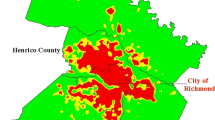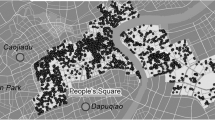Abstract
Urban forms can transform from monocentric to polycentric structures. Identification of urban forms can be done with various methodologies such as using commuter flows and employment density. This research aimed to identify the location of the employment sub-centre and find out urban forms based on commuting patterns in the Bandung metropolitan area. The method used is quantitative analysis with locally weighted regression (LWR) and general functional polycentricity (Pgf) index. The results showed that traditional commuting still dominates with Bandung city as the main destination for commuting and Bandung Regency as the largest commuting sending area. There are six sub-districts that become employment sub-centres that have spread across three regencies/cities. However, the polycentricity index produces a value of 0.028 indicating that urban forms still tend to be monocentric. This condition indicates that although there is a sub-centre of employment in the suburban area, the flow of population mobility still tends to lead to Bandung city as a metropolitan center. Thus, the urban form in the Bandung metropolitan area still tends to be monocentric or weakly polycentric.






Similar content being viewed by others
Availability of data and material
The data used is with the authors and can be available upon demand.
References
Alonso, W. (1964). Location and land use: Toward a general theory of land rent (publication of the joint center for urban studies). Harvard University Press.
Amri, I., & Giyarsih, S. R. (2020). Quantifying urban physical growth types in Banda Aceh City after the 2004 Indian Ocean Tsunami. E3S Web of Conferences, 200(1), 03014. https://doi.org/10.1051/e3sconf/202020007003
Amri, I., & Giyarsih, S. R. (2022). Monitoring urban physical growth in tsunami-affected areas: A case study of Banda Aceh city, Indonesia. GeoJournal, 87(3), 1929–1944. https://doi.org/10.1007/s10708-020-10362-6
Amri, I., Alami, R. R., & Serlia, A. (2023). Population distribution analysis in Banda Aceh City for tsunami disaster risk reduction. IOP Conference Series: Earth and Environmental Science, 1173(1), 012052. https://doi.org/10.1088/1755-1315/1173/1/012052
Anas, A., Arnott, R., & Small, K. A. (1998). Urban spatial structure. Journal of Economic Literature, 36(3), 1426–1464.
Antipova, A., & Ozdenerol, E. (2013). Using longitudinal employer dynamics (LED) data for the analysis of Memphis aerotropolis, Tennessee. Applied Geography, 42, 48–62. https://doi.org/10.1016/j.apgeog.2013.04.013
Arribas-Bel, D., & Sanz-Gracia, F. (2014). The validity of the Monocentric city model in a polycentric age: US metropolitan areas in 1990, 2000 and 2010. Urban Geography, 35(7), 980–997. https://doi.org/10.1080/02723638.2014.940693
Asian Development Bank. (2019). Asian Development Outlook 2019 Fostering Growth And Inclusion In Asia’s Cities.
Badan Pusat Statistik. (2012). Penduduk Indonesia hasil sensus penduduk 2010. BPS.
Badan Pusat Statistik. (2015). Proyeksi penduduk kabupaten/kota provinsi Jawa Barat 2010–2020. BPS.
Badan Pusat Statistik. (2017a). Analisis mobilitas tenaga kerja hasil SAKERNAS 2016. BPS.
Badan Pusat Statistik. (2017b). Statistik komuter Bandung Raya (Hasil survei komuter Bandung Raya dan gerbangkertosusilo 2017). BPS.
Badan Pusat Statistik. (2018). Indikator pasar tenaga kerja Indonesia Agustus 2018. BPS.
Bappenas. (2019). Ringkasan eksekutif visi Indonesia 2045. Bappenas.
Burger, M. J., & Meijers, E. J. (2012). Form follows function? Linking Morphological and Functional Polycentricity, Urban Studies, 49(5), 1127–1149. https://doi.org/10.1177/0042098011407095
Burger, M. J., de Goei, B., Van der Laan, L., & Huisman, F. J. (2011). Heterogeneous development of metropolitan spatial structure: Evidence from commuting patterns in English and Welsh city-regions, 1981–2001. Cities, 28(2), 160–170. https://doi.org/10.1016/j.cities.2010.11.006
Cheema, S., & Rondinelli, G. (1983). Decentralization in developing countries: A review of recent experience. Working Paper. The World Bank. Washington. https://documents1.worldbank.org/curated/en/868391468740679709/pdf/multi0page.pdf
Cowell, M. (2010). Polycentric regions: Comparing complementarity and institutional governance in the San Francisco Bay Area, the Randstad and Emilia-Romagna. Urban Studies, 47(5), 945–965. https://doi.org/10.1177/0042098009353074
De Goei, B., Burger, M. J., Van Oort, F. G., & Kitson, M. (2010). Functional polycentrism and urban network development in the greater South East, United Kingdom: Evidence from commuting patterns, 1981–2001. Regional Studies, 44(9), 1149–1170. https://doi.org/10.1080/00343400903365102
Fahmi, F. Z., Hudalah, D., Rahayu, P., & Wotjer, J. (2014). Extended urbanization in small and medium-sized cities: The case of Cirebon, Indonesia. Habitat International, 42, 1–10. https://doi.org/10.1016/j.habitatint.2013.10.003
Green, N. (2007). Functional polycentricity: A formal definition in terms of social network analysis. Urban Studies, 44(11), 2077–2103. https://doi.org/10.1080/00420980701518941
Hall, P. & Green, N. (2005). POLYNET Action 1.1: Commuting and the definition of functional urban regions: South East England. London: Institute of Community Studies/The Young Foundation and Polynet Partners.
Hall, P., & Pain, K. (2006). The polycentric metropolis: Learning from megacity regions in Europe. Earthscan.
Harahap, F. R. (2013). Dampak urbanisasi bagi perkembangan kota di Indonesia. Jurnal Society, 1(1), 35–45. https://doi.org/10.33019/society.v1i1.40
Hong, S. H., Lee, B. S., & McDonald, J. F. (2018). Commuting time decisions for two-worker households in Korea. Regional Science and Urban Economics, 69, 122–129. https://doi.org/10.1016/j.regsciurbeco.2018.01.010
Hu, L., Sun, T., & Wang, L. (2018). Evolving urban spatial structure and commuting patterns: A case study of Beijing, China. Transportation Research Part D, 59, 11–22. https://doi.org/10.1016/j.trd.2017.12.007
Indriasari, F. (2022). Identifikasi struktur ruang perkotaan berdasarkan kepadatan pekerja dan pola komuter di Kawasan Metropolitan Cekungan Bandung. Thesis. Universitas Gadjah Mada.
Jun, M. J. (2020). The effects of polycentric evolution on commute times in a polycentric compact city: A case of the Seoul metropolitan area. Cities, 98(9), 102587. https://doi.org/10.1016/j.cities.2019.102587
Katherina, L. K., & Indraprahasta, G. S. (2019). Urbanization pattern in Indonesia’s secondary cities: Greater surabaya and its path toward a megacity. IOP Conference Series: Earth and Environmental Science. https://doi.org/10.1088/1755-1315/338/1/012018
Kim, H., Lee, N., & Kim, S. N. (2018). Suburbia in evolution: Exploring polycentricity and suburban typologies in the Seoul metropolitan area, South Korea. Land Use Policy, 75(1), 92–101. https://doi.org/10.1016/j.landusepol.2018.03.033
Kloosterman, R. C., & Musterd, S. (2001). The polycentric urban region: Towards a research agenda. Urban Studies, 38(4), 623–633. https://doi.org/10.1080/00420980120035259
Li, X., Mou, Y., Wang, H., Yin, C., & He, Q. (2018). How does polycentric urban form affect urban commuting? Quantitative Measurement using geographical big data of 100 cities in China. Sustainability. https://doi.org/10.3390/su10124566
Liu, Y., Fan, P., Yue, W., Huang, J., Li, D., & Tian, Z. (2019). Assessing polycentric urban development in mountainous cities: The case of Chongqing metropolitan area. China. Sustainability. https://doi.org/10.3390/su11102790
Mariyanti, T. (2010). Pengaruh industrialisasi terhadap migrasi per propinsi di Indonesia pada tahun. Media Ekonomi, 18(1), 1–24. https://doi.org/10.25105/me.v18i1.6
Mardiansjah, F. H., & Rahayu, P. (2019). Urbanisasi dan pertumbuhan kota-kota di Indonesia: Suatu perbandingan antar-wilayah makro Indonesia. Jurnal Pengembangan Kota, 7(1), 91–110. https://doi.org/10.14710/jpk.7.1.91-108
McMillen, D. P. (2001). Nonparametric employment subcenter identification. Journal of Urban Economics, 50(3), 448–473. https://doi.org/10.1006/juec.2001.2228
McMillen, D. P. (2002). Nonparametric employment subcenter identification. Journal of Urban Economics, 50(3), 448–473. https://doi.org/10.1006/juec.2001.2228
Meijers, E. J., & Burger, M. J. (2010). Spatial structure and productivity in US metropolitan areas. Environment and Planning a: Economy and Space, 42(6), 1383–1402. https://doi.org/10.1068/a42151
Parisi, C. D. A., Kubota, T., & Surahman, U. (2021). Affordable modifications for sustainable houses in urban informal settlements: a case study of Bandung, Indonesia. International Journal of Urban Sustainable Development, 13(3), 659–689. https://doi.org/10.1068/a42151
Parr, J. (2004). The polycentric urban region: A closer inspection. Regional Studies, 38(3), 231–240. https://doi.org/10.1080/003434042000211114
Phelps, N. A., & Ohashi, H. (2020). Edge city denied? The rise and fall of Tokyo’s outer suburban “Business Core Cities.” Journal of Planning Education and Research, 40(4), 379–392. https://doi.org/10.1177/0739456X18773471
Sadewo, E., Syabri, I., Antipova, A., Pradono, & Hudalah, D. (2020). Using morphological and functional polycentricity analyses to study the Indonesian urban spatial structure: The case of medan, jakarta, and denpasar. Asian Geographer, 38(1), 47–71. https://doi.org/10.1080/10225706.2020.1737829
Sadewo, E. (2021). Dampak post-suburbanisasi terhadap perubahan struktur spasial perkotaan dan pola komuter di kawasan pinggiran metropolitan Jabodetabek. Dissertation. Institut Teknologi Bandung.
Schwanen, T., Dieleman, F. M., & Dijst, M. (2004). The impact of metropolitan structure on commute behavior in the Netherlands: A multilevel approach. Growth and Change, 35(3), 304–333. https://doi.org/10.1111/j.1468-2257.2004.00251.x
Sharifi, A. (2019). Resilient urban forms: A macro-scale analysis. Cities, 85(6), 1–14. https://doi.org/10.1016/j.cities.2018.11.023
Sun, B., He, Z., Zhang, T., & Wang, R. (2016). Urban spatial structure and commute duration: An empirical study of China. International Journal of Sustainable Transportation, 10(7), 638–644. https://doi.org/10.1080/15568318.2015.1042175
Sun, B., Ermagun, A., & Dan, Bo. (2017). Built environmental impacts on commuting mode choice and distance: Evidence from Shanghai. Transportation Research Part D, 52, 441–453. https://doi.org/10.1016/j.trd.2016.06.001
Sun, T. (2020). A longitudinal study of changes in intra-metropolitan employment concentration in Beijing: Decentralisation, reconcentration and polycentrification. Urban Studies, 57(4), 748–765. https://doi.org/10.1177/0042098019861382
United Nation. (2014). World urbanization prospect: The 2014 revision. New York: United Nation. https://population.un.org/wup/Publications/Files/WUP2014-Report.pdf
Van Der Laan, L. (1998). Changing urban systems, an empirical analysis at two spatial levels. Regional Studies, 32(3), 235–247. https://doi.org/10.1080/00343409850119733
Van Oort, F., Burger, M. & Raspe, O. (2010) On the economic foundation of the urban network paradigm. Spatial integration, functional integration and complementarities within the Dutch Randstad. Urban Studies, 47(4), 725–748. https://doi.org/10.1177/0042098009352362
Yue, W., Liu, Y., & Fan, P. (2010). Polycentric urban development: The case of Hangzhou. Environment and Planning a: Economy and Space, 42(3), 563–577. https://doi.org/10.1068/a42116
Yue, W., Tianyu, W., Yong, L., Qun, Z., & Xinyue, Y. (2019). Mismatch of morphological and functional polycentricity in Chinese cities: An evidence from land development and funcional linkage. Land Use Policy. https://doi.org/10.1016/j.landusepol.2019.104176
Acknowledgements
This paper is a further development of the thesis written by the first author under the guidance of the second and third authors.
Funding
The authors would like to thank BPS-Statistics Indonesia for financing this research activity through the Magister Thesis Research Scheme in the fiscal year 2020 with contract SPTB number 115/PTB-01/VIII/2020.
Author information
Authors and Affiliations
Corresponding author
Ethics declarations
Conflict of interest
The authors confirm this research is original and there is no conflict of interest for this research.
Ethical approval
The authors obtained permission to conduct the study from the local authorities. Informed consent was obtained from all participants included in the study.
Additional information
Publisher's Note
Springer Nature remains neutral with regard to jurisdictional claims in published maps and institutional affiliations.
Rights and permissions
Springer Nature or its licensor (e.g. a society or other partner) holds exclusive rights to this article under a publishing agreement with the author(s) or other rightsholder(s); author self-archiving of the accepted manuscript version of this article is solely governed by the terms of such publishing agreement and applicable law.
About this article
Cite this article
Indriasari, F., Giyarsih, S.R. & Marwasta, D. Identification of urban form in the Bandung metropolitan area. GeoJournal 88, 5271–5285 (2023). https://doi.org/10.1007/s10708-023-10914-6
Accepted:
Published:
Issue Date:
DOI: https://doi.org/10.1007/s10708-023-10914-6




